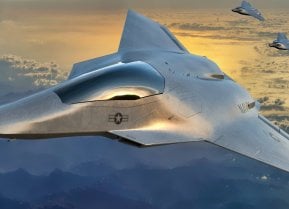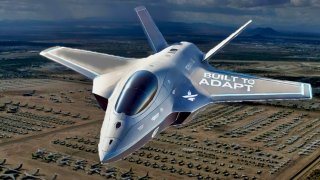The U.S. Air Force's Light Fighter 'Dream' Has Problems
Air Force Chief of Staff General David Allvin has suggested a shift away from the costly, long-lasting fighter programs like the Next Generation Air Dominance (NGAD) fighter in favor of more adaptable, smaller, and cheaper modular aircraft.
Summary: Air Force Chief of Staff General David Allvin has suggested a shift away from the costly, long-lasting fighter programs like the Next Generation Air Dominance (NGAD) fighter in favor of more adaptable, smaller, and cheaper modular aircraft.
-This approach, inspired by the success of the F-16 in the Lightweight Fighter Program, would prioritize open-system architectures that allow for easier upgrades and reduced sustainment costs over time.
-The idea echoes previous proposals, such as the "Digital Century Series," aiming to shorten development cycles and ensure that fighters remain relevant in an ever-changing battlefield.
-However, transitioning to this model poses significant political and industrial challenges.
Light Fighter: How NGAD Gets Replaced?
Some senior Air Force officials are now pointing toward a dramatic shift in America’s next stealth fighter program, with high-cost and high-capability platforms like the Next Generation Air Dominance (NGAD) fighter in development potentially shelved in favor of smaller, lighter, and cheaper aircraft built to adapt to new challenges over time.
This “light fighter” concept was brought to the forefront of discussions about the future of American airpower by Air Force Chief of Staff General David Allvin at the Global Air and Space Chiefs’ Conference by the UK’s Air and Space Power Association in London late in July 20
24, and was first brought to our attention by journalist Parth Satam at The Aviationist.
During his presentation, General Allvin proposed a significant shift in America’s developmental approach to fielding new fighters, doing away with the longstanding “built to last” design approach that’s predicated on fielding advanced and supremely expensive new fighters meant to operate for a half-century or more. Instead, Allvin suggested, new fighter designs should be “built to adapt,” shifting focus away from long-term survivability and instead toward highly modular designs that can be quickly and easily modified to meet the ever-shifting challenges of the 21st-century battlefield.
Although Allvin did not mention the NGAD program in his remarks, these statements echo those made by others about the new air superiority fighter effort being placed in a strategic pause as the Air Force considers significant revisions to its design and operating model.
The “light fighter” versus “heavy fighter” nomenclature that’s been attributed to Allvin’s concept (he notably didn’t use the terminology himself) is reminiscent of the Lightweight Fighter Program that produced the F-16 as a low-cost wingman for the supremely expensive at the time F-15 Eagle. The F-16’s design focus, of course, was not on modularity or technological adaptability, but was nonetheless groundbreaking thanks to its emphasis on the energy–maneuverability theory of aerobatic performance and its first-of-its-kind adoption of fly-by-wire controls.
But while the F-16 delivered important technological breakthroughs, its real claim to fame was the ability to fight well above its weight class for a serious bargain — ringing it at just more than half the price of the heavy F-15 per jet. This allowed the U.S. Air Force to embrace what’s commonly known as a “high/low mix” of fighters — an approach that’s transitioned over the years to see both the F-15 and F-16 as “low” end fighters, with the F-22 and F-35 assuming the “high” end role.
Allvin argued that America’s existing approach to fighter design, which sees lengthy developmental timelines followed by high-cost procurements and even higher-cost sustainment, is predicated on the “underlying assumption” that the fighters will stay technologically relevant for long enough to substantiate the mountains of funding dollars the programs burn through. But with a long list of foreign nations now fielding stealth fighters of their own and emerging technologies like artificial intelligence promising to make air defense systems more capable than ever, Allvin believes that “underlying assumption” no longer holds true.
“That proposition can become an albatross. It’s still functioning but it’s not as effective,” Allvin said of these high-end fighters as their lifespans wear on.
The Light Fighter Concept and the Digital Century Series
Instead of repeating the lengthy development timelines of today’s top-tier American fighters like the F-22 and F-35, each of which stretched more than two decades between early developmental onset and reaching operational service, Allvin called for leaning further into open system software architecture and supremely modular designs that could be rapidly upgraded or even discarded in favor of newer designs that would share common systems with the previous model.
This is not a new concept for the U.S. Air Force, and in fact, has been the subject of multiple discussions in recent years both related and unrelated to the Next Generation Air Dominance fighter program that has been underway, in one form or another, for a solid decade already. While many have dubbed Allvin’s proposal a new “notional light fighter concept,” a very similar concept was proposed by Air Force acquisition chief Will Roper in 2019 as what he called the “digital century series.”
That title, of course, draws inspiration from the rapidly changing fighter designs of the 1950s collectively known as the “Century Series” – a half dozen fighters ranging from the North American F-100 Super Sabre that entered service in 1954 to the Convair F-106 Delta Dart that followed suit in 1959.
In a similar era of rapid advancements in aviation technology, the original Century series placed a significant emphasis on what a 1960 Rand Corporation analysis described as an attempt “to develop aircraft that embody state-in-the-art [sic] advances and the flexibility with which aircraft subsystems, once developed, could be employed in systems for which they were not originally designed.”
In other words, the original Century Series of fighters aimed to make rapid technological progress through the use of somewhat modular avionics systems and other onboard equipment that could be reused in subsequent aircraft designs, rather than needing to devise entirely new hardware for each. Roper’s more modern “Digital Century Series” would take that concept to the next level, using digital engineering and virtual testing environments to rapidly mature fighter designs and subsystems toward service in modern modular fighters.
General Allvin also provided vocal support for Roper’s pitch at the time, saying, “‘Built to last’ is a tremendous 20th-century bumper sticker, and the assumption then was, whatever you had was relevant as long as it lasts. I’m not sure that’s true anymore.”
In 2021, a similar concept was also discussed by then-Air Force Chief of Staff (and current Chairman of the Joint Chiefs of Staff) General Charles “CQ” Brown, who suggested the branch shift toward fielding what many called a “5th generation minus” fighter design that would leverage modular systems based on those developed for the F-22 and F-35 in lower-cost aircraft with shorter service lives.
This would allow for rapid advancements in aircraft design and performance, as each new fighter iteration would be similar to the last with a series of improvements cultivated through experience with the previous design. Pilots and maintainers transitioning from one aircraft to the next would face minimal training challenges, as the majority of the systems and aircraft functionality would remain the same.
Rather than fielding a new clean-sheet fighter design every ten years, the majority of the previous fighter airframe and systems would be retained from one iteration to the next, swapping out only the design elements or internal components that need to be upgraded or changed to suit the shifting needs of the modern battlefield. One iteration might come with a different wing or tail design, meant to improve stealth, range, or loiter time, while the cockpit, avionics, and other onboard equipment could remain unchanged. Modular avionics systems could simply be swapped out of existing jets, or replaced in the next iteration, resulting in a rotating fleet of fighters that are overwhelmingly similar to one another for the sake of training and maintenance, but that continuously field new technologies or design methodologies meant to offset advancements in adversary defenses.
Breathing new life into the fighter industry
Shortening the intended service lives of fighters could potentially have even more benefits than ensuring the latest and greatest fighter tech is making it into the sky; it could also help to reinvigorate America’s increasingly anemic fighter industry and dramatically reduce the most expensive part of any modern fighter program — it’s long-term sustainment.
Today, there are only three large American firms still in the fighter business — Lockheed Martin, Northrop Grumman, and Boeing — with little promise of any other company ever getting a foot in the door because new fighter programs are so few and far between. With Lockheed Martin securing contracts for both the F-22 and F-35, it’s been over four decades since the U.S. fielded a completely new clean-sheet fighter design that didn’t come from Lockheed’s Skunk Works. With Lockheed Martin seen by many as the potential favorite for the Next Generation Air Dominance competition, it’s entirely feasible that Lockheed Martin could maintain that new-fighter-design monopoly beyond the half-century mark or further.
With so few fighter contracts to go around, there’s no opportunity, let alone incentive, for any other company to try throwing their hats into the fighter ring.
But, a shift toward fielding fighters only meant to serve for a decade or so would mean that initial development on the next fighter could begin as soon as the current one enters service. And by using open system software architecture meant to ensure components and systems developed by any company can integrate and work seamlessly with systems built by any other, each new fighter design would only need to swap out upgraded systems, while retaining the old to keep costs down. This could even allow for smaller companies to submit their own modular designs using the same open framework.


